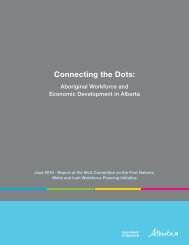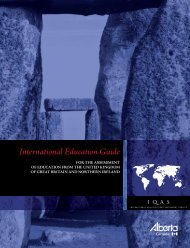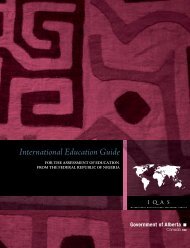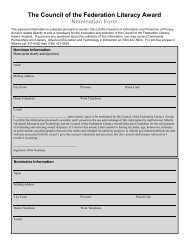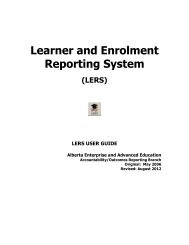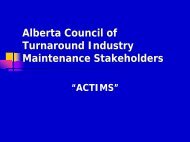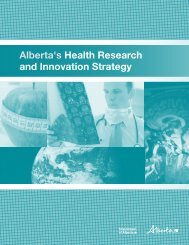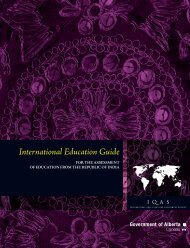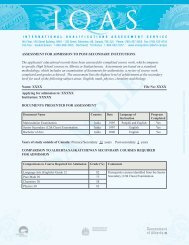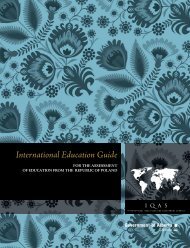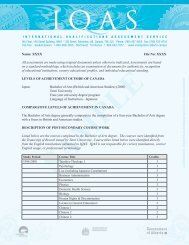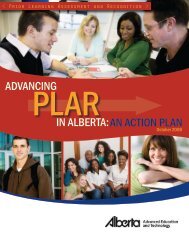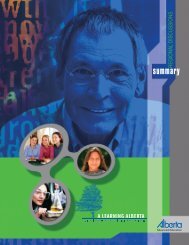International Education Guide - Enterprise and Advanced Education ...
International Education Guide - Enterprise and Advanced Education ...
International Education Guide - Enterprise and Advanced Education ...
You also want an ePaper? Increase the reach of your titles
YUMPU automatically turns print PDFs into web optimized ePapers that Google loves.
.12<br />
INTERNATIONAL EDUCATION GUIDE for the assessment of education from the Islamic Republic of Pakistan<br />
Private Schools<br />
Before 1972, privately managed institutions at the school<br />
<strong>and</strong> college levels constituted an important part of the<br />
education system. They were funded by student fees <strong>and</strong><br />
donations <strong>and</strong> also received government grants-in-aid. In<br />
1972 the federal government decided to nationalize all<br />
private institutions. More than 19,000 private institutions,<br />
including schools, madrassas, colleges <strong>and</strong> technical<br />
institutions, were nationalized. However, inadequate<br />
funding <strong>and</strong> poor management soon led to the deterioration<br />
of st<strong>and</strong>ards at the newly nationalized schools. The policy<br />
was reversed in 1979 when the government acknowledged it<br />
must encourage the establishment of private institutions to<br />
tackle the poor participation rates at all levels of education.<br />
Partly due to the poor quality of government-funded<br />
schools, private education is playing an increasingly<br />
important role. In 2003–04, students in private schools<br />
accounted for 42 per cent of total enrolment at the<br />
primary level, 37 per cent at the middle school level, 30 per<br />
cent at the secondary level <strong>and</strong> 64 per cent at the higher<br />
secondary level.<br />
The quality of education at private schools, although<br />
uneven, generally compares favourably with that at<br />
government schools. While some schools, especially in<br />
poor <strong>and</strong> remote areas, charge very low fees <strong>and</strong> offer fee<br />
waivers or scholarships, others cater to high income families<br />
in urban areas. Some English-language private schools<br />
that prepare students for the British General Certificate<br />
of <strong>Education</strong> A <strong>and</strong> O Level examinations or the United<br />
States SATs have reputations for high quality. Englishlanguage<br />
schools are popular with parents, who believe<br />
the knowledge of English opens up more opportunities for<br />
their children in both employment <strong>and</strong> further education,<br />
as English is the working language in higher levels of the<br />
Pakistani military <strong>and</strong> bureaucracy.<br />
Madrassas<br />
In addition to the regular government-funded education<br />
system, Pakistan has a network of religious seminaries,<br />
commonly known as madrassas or madaris, which teach<br />
Islamic religion, culture, arts <strong>and</strong> sciences at primary<br />
through graduate levels.<br />
Madrassas date back to the Islamic period in Indian<br />
history. Under British rule the number of madrassas<br />
<strong>and</strong> their enrolment declined steadily. At the time of<br />
independence in 1947, there were only about a hundred<br />
madrassas in Pakistan. Since the late 1970s the system has<br />
exp<strong>and</strong>ed rapidly. The deteriorating infrastructure <strong>and</strong><br />
falling st<strong>and</strong>ards at government-funded schools <strong>and</strong> their<br />
failure to provide an education that is considered relevant<br />
to the everyday life <strong>and</strong> economic necessities of the poorer<br />
sectors of the population partially account for the boom<br />
of madrassas. In 2002 there were an estimated 10,000<br />
madrassas with a total enrolment of 1.7 million.<br />
Main subjects taught at the madrassas include the Koran,<br />
Islamic law <strong>and</strong> jurisprudence, logic <strong>and</strong> the tradition of the<br />
Prophet. The language of instruction is Urdu or a regional<br />
language such as Sindhi, but students also learn Arabic<br />
<strong>and</strong> Persian from ancient religious texts. The vast majority<br />
of madrassas are funded by charity <strong>and</strong>, in some cases, by<br />
foreign donors. As they generally charge no tuition fees <strong>and</strong><br />
even provide free room <strong>and</strong> board, they attract very poor<br />
students who could not otherwise afford any education.<br />
While many madrassas remain unregistered, the registered<br />
ones mostly belong to five religious education boards that<br />
prescribe the curricula, conduct examinations <strong>and</strong> award<br />
certificates to successful c<strong>and</strong>idates:<br />
• Wafaq-ul-Madaris Al-Arabia, Multan<br />
• Tanzeem-ul-Madaris Alhe Sunnat, Lahore<br />
• Wafaq-ul-Madaris Al-Salfia, Faisalabad<br />
• Wafaq-ul-Madaris Shia, Lahore<br />
• Rabita-ul-Madaris Al Islamia, Lahore<br />
The major madrass certificates (called sanad) are:<br />
Shahadatul Almiya (2 years)<br />
Shahadatul alia (2 years)<br />
Shahadatul sanvia khasa (2 years)<br />
Shahadatul sanvia aama (2 years)<br />
middle school certificiate or equivalent<br />
(8 years of schooling)




